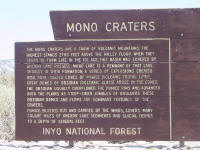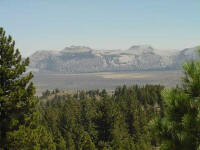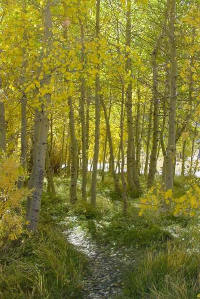
Quaking Aspen
June Lake Loop
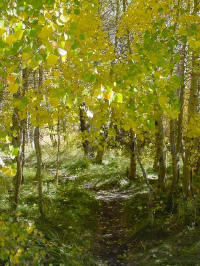
Quaking Aspen
June Lake Loop
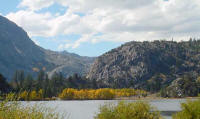
Gull Lake
June Lake Loop
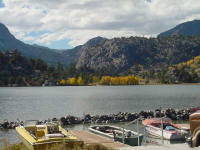
Gull Lake
June Lake Loop
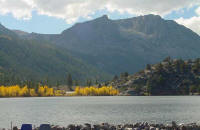
Gull Lake
June Lake Loop
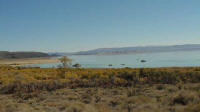
Mono Lake North West Corner
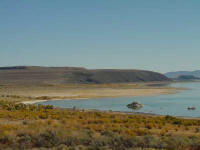
Mono Lake North West Corner
Mono Lake is a majestic body of water, located 2 hours south of Lake Tahoe on Highway 395, covering about 60 square miles. It is an ancient lake, over 700,000 years old -- one of the oldest lakes in North America. It has no outlet. Throughout its long existence, salts and minerals have washed into the lake from Eastern Sierran streams. Freshwater evaporating from the lake each year has left the salts and minerals behind so that the lake is now about 2 1/2 times as salty and 80 times as alkaline as the ocean.
The Mono Basin Scenic Area Visitor Center is a great place to start your visit to this area. The center is located just off Highway 395, north of Lee Vining and includes a variety of exhibits about the natural and human history of the Mono Basin. Visitor center staffmembers stand ready to help you plan your explorations of Mono Lake and the Eastern Sierra.
Hiking, swimming, boating, and cross-country skiing are just a few of the many activities you can enjoy at this unusual lake. Photographers come from all over the world to capture the interplay of light, desert, and water. The natural history of the lake is described and explained in a one-mile self-guided nature trail at South Tufa. This spectacular tufa area is the best place to visit if you have time for only one stop. A boardwalk trail below the Mono Lake County Park allows access to the north shore tufa area and marsh. A trail at Panum Crater leads to the dome and crater rim.
A swim in Mono Lake is a memorable experience. The lake's salty water is denser than ocean water, and provides a delightfully buoyant swim. Old timers claim that a soak in the lake will cure almost anything. Keep the water out of your eyes or any cuts, as it will sting.
Tufa Towers
The tufa towers are the most obvious geological feature at Mono Lake. These unusual spires and knobs are formed when calcium-bearing freshwater springs well up through alkaline lake water, which is rich in carbonates. The calcium and carbonate combine, precipitating out as limestone. Over many years, a tower forms around the mouth of the spring. This tufa-forming reaction happens only in the lake itself. As the lake level drops, exposing the towers, they cease to grow.
The Mono Basin is also filled with volcanoes. Black Point erupted under the Ice Age Mono Lake about 13,000 years ago, and is now totally exposed on the north shore. To the south lie the Mono Craters, the youngest mountain chain in North America. Mono's islands are also volcanic in nature.
Evidence of the Mono Basin's Ice Age glaciers can be seen in the moraines at the mouths of Bloody Canyon, Lee Vining Canyon, and Lundy Canyon.
A Living Lake
Mono Lake has been called a "dead sea" but it actually abounds with life. Few animals can tolerate Mono's salty, alkaline water, but these few species thrive in astronomical numbers.
The food chain begins with green algae, a microscopic one-celled plant. Two animals feast on the algae: the brine shrimp and the alkali fly. The brine shrimp is a half inch wriggly creature that, according to Mark Twain, looks "like a bit of thread frayed out at the edges". An estimated 4 trillion brine shrimp ply Mono's waters in the warm season, then over-winter as eggs. The alkali flies number in the millions and look similar to a house fly. The pupae stage of the alkali fly was used as a food source by the Kuzedika Paiute Indians.
Mono's shrimp and flies provide plentiful food for more than 80 species of migratory birds that visit the lake in the spring and summer. Particularly notable bird species include three migrants: the eared grebe, Wilson's phalarope, and the red-necked phalarope; and two nesting species -- the California gull and the snowy plover.
Winter at Mono Lake
Winter is a particularly beautiful time at Mono Lake. The crowds are gone, a quiet stillness prevails, and snow crystals sparkle on the tufa towers. The road to South Tufa is kept plowed, allowing year round access except immediately after the biggest storms. South Tufa, Old Marina, and the County Park boardwalk are all wonderful places to cross-country ski when snow conditions permit.
Water Issues
In 1941 the city of Los Angeles began diverting four of the five major streams that feed Mono Lake. Without that water, the lake dropped approximately forty feet and doubled in salinity. Concerns about the lake's ecosytem and about the effects of wind-blown alkali dust on Mono Basin air quality, as well as the esthetics of a shrimking lake, led citizen groups (the Mono Lake Committee and National Audubon Society) to begin the legal effort to protect Mono lake. On September 28, 1994, after 16 years of court battles, research and formal hearings, the State Water Resources Control Board issued an order to protect Mono Lake and its tributary streams. The order will raise the lake level by 17 feet to an elevation of 6,392 feet above sea level, over the next 20 years. All parties involved agreed to accept this plan and implement it in a spirit of cooperation. While the lake may be saved on paper, much remains to be done. Stream and waterfowl habitat restoration efforts are underway with imput from Scenic Area and Reserve staff. The question today is not whether Mono Lake will be saved, but how it will be saved.
Camping and Boating
The State Reserve is surrounded by the Mono Basin National Forest Scenic Area, operated by the Forest Service. There are no campgrounds in the State Reserve or the Scenic Area. Dispersed camping is permitted in most of the Scenic Area outside the exposed lake bed lands. Campfire permits are required. Established campgrounds are located in Lundy Canyon, Lee Vining Canyon, and the June Lake Loop. All types of boating are permitted on Mono Lake, although access is restricted to Negit and Paoha Islands between April 1 and August 1 each year to protect the nesting gulls. It is advisable to stay near shore while boating, and to be alert for sudden high winds.
We recommend launching canoes and kayaks at Navy Beach, on the south shore, where a parking lot is close to the water. For those with boats too large to carry, a launch ramp is available near Lee Vining Creek. Stop by the Scenic Area Visitor Center for directions.
Interpretive Programs
Rangers lead tufa walks throughout the year at the South Tufa area. The usual schedule is 1 pm on Saturday and Sunday from October 1st through mid-June. Tours are offered 3 times daily from July 1 through Labor Day (10am, 1pm, and 6pm); and daily at 1pm in September. Tours of Panum Crater are offered in the summer, as well as Star Shows on the south shore of the lake. Cross-country ski tours are offered in winter when snow conditions permit. A spooky Halloween Moonlight Walk is offered each October.
Interpretive programs are a cooperative effort of the State Reserve, U.S. Forest Service and the Mono Lake Committee."
